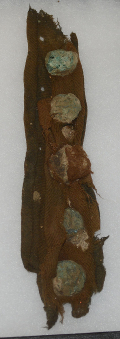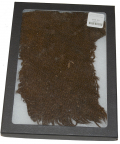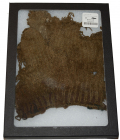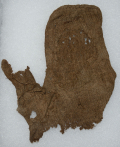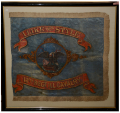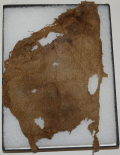site search
online catalog
Uniforms & Cloth
Showing 21 to 40 out of 191
MAKER MARKED AMERICAN MILITARY OFFICER’S CHAPEAU CA. 1825-1835
This scarce American military officer’s chapeau has a largely intact white silk lining bearing a black maker’s stamp reading “C. St. JOHN. / 118 / BROADWAY, New York.” Bazelon places Charles… (413-01). Learn More »
$1,750.00
Originally $2,450.00
1863 PATTERN US CAVALRY GUIDON FROM THE 1st CONNECTICUT CAVALRY
This cavalry guidon was formerly in the personal collection of Jim Stamatelos, well known Civil War collector, dealer, and major contributor of items illustrated in the Time-Life volume “Echoes of… (433-14). Learn More »
PIECE OF AN INDIAN WAR M1872 FATIGUE BLOUSE OR DRESS COAT FROM FORT PEMBINA, ND
This is a piece from the lapel of a US Army jacket showing part of the blue outer fabric, the lining and the remains of five corroded brass buttons. From the size and spacing of the buttons this is… (1052-608). Learn More »
PIECE OF CIVIL WAR ARMY BLANKET FROM FORT PEMBINA, NORTH DAKOTA
The army had vast stocks of Civil War material left over at the end of the war. These supplies, along with the reduction of the postwar army meant U.S. troops were getting Civil War gear well into the… (1052-617). Learn More »
SCARCE INDIAN WAR SOLDIER’S MITTEN FROM FORT PEMBINA, ND
This comes from the excavations at Fort Pembina, occupied 1870-1895, where cold weather in winter months might well be a concern. The army began issuing mittens in 1873. Before that men were left to… (1052-620). Learn More »
INDIAN WAR SOLDIER’S MITTEN FROM FORT PEMBINA, ND
This comes from the excavations at Fort Pembina, occupied 1870-1895, where cold weather in winter months might well be a concern. The army began issuing mittens in 1873. Before that men were left to… (1052-619). Learn More »
FLY FROM INDIAN WAR SOLDIER’S TROUSERS, FORT PEMBINA, ND
This comes from the excavations at Fort Pembina, occupied 1870-1895, where the wet, anaerobic soil conditions of the dig (conducted on private property with the owner’s permission,) have yielded… (1052-599). Learn More »
$65.00
ON HOLD
WONDERFUL CONDITION ORIGINAL CONFEDERATE-MANUFACTURED KEPI FOR A DRUMMER BOY OR CHILD
This article of uniform clothing is an original, Civil War example of headgear manufactured in the Confederacy and presented here in wonderful, original intact condition. The period artifact is a… (526-68). Learn More »
$4,750.00
Originally $6,500.00
7TH ARMY CORPS FLAG FOR G.A.R. HALL OR ENCAMPMENT USE
Measures 18 ½” x 25”, circa 1890-1900. The corps badge design is two-sided, sewn on with two rows of zig-zag stitching. There is also an inner accent stitching. Overall condition is fine, with… (399-18). Learn More »
$175.00
Originally $250.00
13-STAR CONFEDERATE FIRST NATIONAL FLAG WITH GETTYSBURG HISTORY - “GRIMES COUNTY GREYS,” CO. G, 4th TEXAS INFANTRY, HOOD’S TEXAS BRIGADE
The flag is in very good condition, with strong colors and just a few scattered small holes that do not detract. It has been archivally conserved, mounted and framed by Textile Preservation Associates… (1179-1393). Learn More »
“I LIKE YOUR STYLE” THE REGIMENTAL STANDARD OF THE 12th ILLINOIS CAVALRY: GAMBLE’S BRIGADE UNDER BUFORD ON JULY 1 AT GETTYSBURG
We can’t think of a more flamboyant, devil-may-care motto on a cavalry standard than this one, whose overtly casual nature no doubt intentionally contrasts with their combat and fighting record.… (1179-033). Learn More »
FIRST NATIONAL CONFEDERATE FLAG OF THE RED RIVER VOLUNTEERS, CO. E 11th TEXAS CAVALRY
This eleven-star First National Confederate Flag was sewn by Mrs. Isabella (“Ibbie”) Haddon Hopkins Gordon of Clarksville, Texas, and presented to the “Red River Volunteers,” later Company E… (1179-1396). Learn More »
FINE PAIR OF RED EPAULETTES
Pair of red wool epaulettes with “eagle A” buttons. Epaulette outer-surfaces feature beautiful, woven red wool with a ribbed border, and thick rows of hanging tassels. A single eagle “A”… (1179-1652). Learn More »
PIECE OF CIVIL WAR ARMY BLANKET FROM FORT PEMBINA, NORTH DAKOTA
The army had vast stocks of Civil War material left over at the end of the war. These supplies, along with the reduction of the postwar army, meant U.S. troops were getting Civil War gear well into… (1052-618). Learn More »
PIECE OF INDIAN MADE ROPE FROM PLANT MATERIAL FROM FORT PEMBINA, NORTH DAKOTA
This is a short section of rope made from twisted and woven plant fibers and comes from excavations at Fort Pembina, ND, conducted on private property with the owner’s permission, a fort established… (1052-720). Learn More »
CIVIL WAR-INDIAN WAR UNIFORM LAPEL FROM FORT PEMBINA
This strip of cloth showing three buttonholes (and what seems to be part of a fourth) is the remnant of an army dress coat discarded after its useful days were done at Fort Pembina, a small frontier… (1052-610). Learn More »
INDIAN WAR SOLDIER’S MITTEN PIECE FROM FORT PEMBINA, ND
This comes from the excavations at Fort Pembina, occupied 1870-1895, where cold weather in winter months might well be a concern. The army began issuing mittens in 1873. Before that men were left to… (1052-621). Learn More »
CIVIL WAR-INDIAN WAR FORAGE CAP VISOR
This is a well preserved leather visor from a forage cap recovered at Fort Pembina, ND, where it was preserved in remarkable condition by wet, anaerobic soil conditions. This is typical of the simple… (1052-485). Learn More »
CIVIL WAR-INDIAN WAR FORAGE CAP VISOR
This is a well preserved leather visor from a forage cap recovered at Fort Pembina, ND, where it was preserved in remarkable condition by wet, anaerobic soil conditions. This is typical of the simple… (1052-482). Learn More »
CIVIL WAR-INDIAN WAR FORAGE CAP VISOR
This is a well preserved leather visor from a forage cap recovered at Fort Pembina, ND, where it was preserved in remarkable condition by wet, anaerobic soil conditions. This is typical of the simple… (1052-481). Learn More »
$45.00
ON HOLD
Showing 21 to 40 out of 191
Most Popular
Historical Firearms Stolen From The National Civil War Museum In Harrisburg, Pa »
Theft From Gravesite Of Gen. John Reynolds »
Selection Of Unframed Prints By Don Troiani »
Fine Condition Brass Infantry Bugle Insignia »
British Imported, Confederate Used Bayonet »
Scarce New Model 1865 Sharps Still In Percussion Near Factory New »
featured item
SCARCE 1859 DATED AMES LIGHT CAVALRY SABER, AKA MODEL 1860
Old habits die hard. Although we now know production of the new pattern cavalry saber intended to replace the heavy Model 1840 started in 1857, most still refer to them as the Model 1860. This is a scarce example of one produced by Ames in 1859 and… (2022-718). Learn More »
site search
Upcoming Events
APRIL 12-13: SPRING GETTYSBURG MILITARY ANTIQUES SHOW; All Star Events Complex Learn More »





